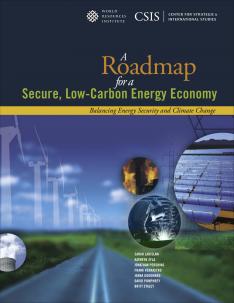A Roadmap for a Secure, Low-Carbon Energy Economy

Synopsis
This "roadmap" presents the results of a year-long effort by the Center for Strategic and International Studies (CSIS) and WRI to identify a set of policies to
address energy security and climate change simultaneously.
Key Findings
This roadmap creates a three-part framework for thinking about the transition to a secure, low-carbon economy. It recommends that the administration and Congress should:
1. Establish a vision for the future. Articulate a long-term vision for addressing energy security and climate change against which all policies will be measured.
- Integrate energy security and climate change priorities into all aspects of domestic and international policymaking.
2. Put the country’s energy system on the right path. “Reset the system” by updating policies and incentives to promote secure, low-carbon technologies and practices.
- Establish a price on carbon throughout the U.S. economy.
- Make and implement a public financial commitment to address energy security and climate change, including devoting resources to improved infrastructure, energy efficiency, and clean-energy jobs.
- Reform incentives to promote low-carbon technologies and remove barriers to their adoption.
- Engage constructively in an effective international response to climate change and energy security concerns.
- Invest in the infrastructure and technology necessary to transform the transportation system while improving land-use planning.
- Promote energy efficiency and other measures that contribute to both energy security and climate goals.
- Reduce the greenhouse gas emissions from technologies that contribute to energy security (coal and biofuels) and make low-carbon technologies (nuclear power and some renewables) more secure.
- Support domestic conventional oil production during the transition to lower-carbon fuels.
- Develop a natural gas strategy to help meet short-term demand and ensure the availability of alternatives in the longer term.
3. Manage the transition. Continue to meet and manage U.S. energy demand while addressing the tradeoffs that occur during the transition to a new energy system.
- Promote energy efficiency and other measures that contribute to both energy security and climate goals.
- Reduce the greenhouse gas emissions from technologies that contribute to energy security (coal and biofuels) and make low-carbon technologies (nuclear power and some renewables) more secure.
- Support domestic conventional oil production during the transition to lower-carbon fuels.
- Develop a natural gas strategy to help meet short-term demand and ensure the availability of alternatives in the longer term.
Executive Summary
At first glance, improving energy security and addressing climate change may seem irreconcilable goals: achieve an adequate, reliable, and affordable energy supply for the United States, while at the same time reducing emissions of dangerous global warming gases into the atmosphere. After all, most of the world’s energy comes from burning fossil fuels such as coal, oil, and natural gas – which are also major sources of greenhouse gases. Without scalable low-carbon replacements for these fuels, actions to reduce emissions could destabilize the current energy system. On the other hand, continued dependence on these fuels will jeopardize our climate.
The hard truth is that the United States---and the world---must now figure out how to achieve energy security and protect Earth’s climate.
There is abundant evidence that the current energy system is unsustainable. Prices are volatile, supplies tight, and security threats---from supply disruptions to geopolitical tension---have become commonplace. The expected environmental and social costs of climate change---sea-level rise, water scarcity, reduced food supplies, and damaged ecosystems---are rising. At the same time, the country is facing an economic crisis that strains public and private budgets, but also raises opportunities to stimulate the economy while building a cleaner and more reliable energy infrastructure in the process.
Solutions to these problems are not always clear. While some strategies – such as energy efficiency measures – benefit climate change and energy security goals, other possible solutions for improving energy security – such as relying more on liquid fuels produced from domestic coal – could significantly worsen climate and other environmental problems. Similarly, some possible climate solutions – such as relying more on the sun or wind to make electricity – could reduce reliable and affordable energy supplies in the short term.
This “roadmap” presents the results of a year-long effort by the Center for Strategic and International Studies (CSIS, an international policy and security-oriented think tank) and the World Resources Institute (WRI, an environmental policy think tank) to identify a set of policies to address energy security and climate change simultaneously. This document presents the results of a difficult process to reconcile the priorities of two sometimes conflicting constituencies. The resulting recommendations are designed to be implemented as a package. Policymakers must not simply pick the recommendations they favor or that are most politically palatable. The balanced approach recommended in this brief would greatly increase the United States’ chances of meeting both its energy security and climate goals.
It won’t be easy. Shifting the United States to a secure, low-carbon economy will take decades. The costs will be high, but they will be even higher if immediate action is not taken. The United States has ample natural, human, and technological resources, and if policymakers get started promptly and make smart decisions, the benefits of this transformation can be great: economic opportunity, a healthier planet, and a more secure future for the United States.